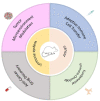Humanized Rodent Models for Cancer Research
- PMID: 33042811
- PMCID: PMC7518015
- DOI: 10.3389/fonc.2020.01696
Humanized Rodent Models for Cancer Research
Abstract
As one of the most popular laboratory animal models, rodents have been playing crucial roles in mechanistic investigations of oncogenesis as well as anticancer drug or regimen discoveries. However, rodent tumors show different or no responses to therapies against human cancers, and thus, in recent years, increased attention has been given to mouse models with xenografted or spontaneous human cancer cells. By combining with the human immune system (HIS) mice, these models have become more sophisticated and robust, enabling in vivo exploration of human cancer immunology and immunotherapy. In this review, we summarize the pros and cons of these humanized mouse models, with a focus on their potential as an in vivo platform for human cancer research. We also discuss the strategies for further improving these models.
Keywords: cancer; humanized mice; immunology; immunotherapy; rodent.
Copyright © 2020 Tian, Lyu, Yang and Hu.
Figures
Similar articles
-
Human Immune System Mice With Autologous Tumor for Modeling Cancer Immunotherapies.Front Immunol. 2020 Oct 8;11:591669. doi: 10.3389/fimmu.2020.591669. eCollection 2020. Front Immunol. 2020. PMID: 33133105 Free PMC article. Review.
-
Cancer Immunotherapies and Humanized Mouse Drug Testing Platforms.Transl Oncol. 2019 Jul;12(7):987-995. doi: 10.1016/j.tranon.2019.04.020. Epub 2019 May 20. Transl Oncol. 2019. PMID: 31121491 Free PMC article. Review.
-
Modeling Tumor Immunology and Immunotherapy in Mice.Trends Cancer. 2018 Sep;4(9):599-601. doi: 10.1016/j.trecan.2018.07.003. Epub 2018 Aug 3. Trends Cancer. 2018. PMID: 30149876
-
Humanized mouse model: a review on preclinical applications for cancer immunotherapy.Am J Cancer Res. 2020 Dec 1;10(12):4568-4584. eCollection 2020. Am J Cancer Res. 2020. PMID: 33415020 Free PMC article. Review.
-
Workshop on challenges, insights, and future directions for mouse and humanized models in cancer immunology and immunotherapy: a report from the associated programs of the 2016 annual meeting for the Society for Immunotherapy of cancer.J Immunother Cancer. 2017 Sep 19;5(1):77. doi: 10.1186/s40425-017-0278-6. J Immunother Cancer. 2017. PMID: 28923102 Free PMC article.
Cited by
-
Homology-independent targeted insertion-mediated derivation of M1-biased macrophages harbouring Megf10 and CD3ζ from human pluripotent stem cells.EBioMedicine. 2024 Nov;109:105390. doi: 10.1016/j.ebiom.2024.105390. Epub 2024 Oct 9. EBioMedicine. 2024. PMID: 39383607 Free PMC article.
-
Transcriptomic Analysis of LNCaP Tumor Xenograft to Elucidate the Components and Mechanisms Contributed by Tumor Environment as Targets for Dietary Prostate Cancer Prevention Studies.Nutrients. 2021 Mar 19;13(3):1000. doi: 10.3390/nu13031000. Nutrients. 2021. PMID: 33808801 Free PMC article.
-
Progress, implications, and challenges in using humanized immune system mice in CAR-T therapy-Application evaluation and improvement.Animal Model Exp Med. 2024 Feb;7(1):3-11. doi: 10.1002/ame2.12353. Epub 2023 Oct 12. Animal Model Exp Med. 2024. PMID: 37823214 Free PMC article. Review.
-
Patient-derived organoid culture in epithelial ovarian cancers-Techniques, applications, and future perspectives.Cancer Med. 2023 Oct;12(19):19714-19731. doi: 10.1002/cam4.6521. Epub 2023 Sep 30. Cancer Med. 2023. PMID: 37776168 Free PMC article. Review.
-
DNA Repair and Therapeutic Strategies in Cancer Stem Cells.Cancers (Basel). 2023 Mar 22;15(6):1897. doi: 10.3390/cancers15061897. Cancers (Basel). 2023. PMID: 36980782 Free PMC article. Review.
References
-
- Hidalgo M, Amant F, Biankin AV, Budinska E, Byrne AT, Caldas C, et al. . Patient-derived xenograft models: an emerging platform for translational cancer research. Cancer Discov. (2014) 4:998–1013. 10.1158/2159-8290.CD-14-0001 - DOI - PMC - PubMed
Publication types
LinkOut - more resources
Full Text Sources
Research Materials
Miscellaneous


